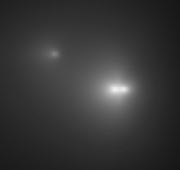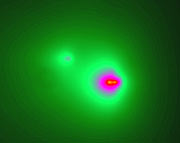Pressemeddelelse
Comet LINEAR Splits Further
Third Nucleus Observed with the VLT
18. maj 2001
New images from the VLT show that one of the two nuclei of Comet LINEAR (C/2001 A2), now about 100 million km from the Earth, has just split into at least two pieces. The three fragments are now moving through space in nearly parallel orbits while they slowly drift apart. This comet will pass through its perihelion (nearest point to the Sun) on May 25, 2001, at a distance of about 116 million kilometres. It has brightened considerably due to the splitting of its "dirty snowball" nucleus and can now be seen with the unaided eye by observers in the southern hemisphere as a faint object in the southern constellation of Lepus (The Hare).
Comet LINEAR splits and brightens
Comet LINEAR was discovered on January 3, 2001, and designated by the International Astronomical Union (IAU) as C/2001 A2 (see IAU Circular 7564 [1]).
Six weeks ago, it was suddenly observed to brighten (IAUC 7605 [1]). Amateurs all over the world saw the comparatively faint comet reaching naked-eye magnitude and soon thereafter, observations with professional telescopes indicated the reason for this strange behaviour: the comet's "dirty snowball" nucleus had split into two pieces (IAUC 7616 [1]).
During the splitting of the nucleus, fresh material from the interior of this frozen body is suddenly exposed to the sunlight, causing a rapid increase in the evaporation process. More cometary material is released and the overall brightness increases, as more sunlight is reflected off the dust around the nucleus.
The VLT observes three fragments
But Comet LINEAR has just shown that it is good for another surprise. When astronomers at ESO's Paranal Observatory [2] turned the 8.2-metre VLT MELIPAL telescope (UT3) towards that object in the evening of May 14, they noted that one of the two pieces of the nucleus appeared somewhat elongated. The comet is rapidly approaching the Sun - it will pass through its perihelion (the point closest to the Sun) on May 25, and it was quite low in the sky (about 20° above the western horizon). Accordingly, the image quality was not perfect, but there was no doubt that something was going on with the fragment that was closest to the Sun (denoted "B").
And indeed, when the 8.2-metre VLT YEPUN telescope (UT4) obtained another image of the comet in the evening of May 16, it was obvious that fragment "B" had split into two, see ESO Press Photos eso0119. In fact, the astronomers suspect that there may be other, smaller pieces.
The distance between the two pieces of nucleus "B" of Comet LINEAR (now denoted "B1" and "B2") was only about 1 arcsec, or approximately 500 km (projected) at the present distance of the comet from the Earth (about 100 million km). The distance between these and the other nucleus ("A") increased from about 6000 km (May 14) to 7000 km (May 16).
The ESO astronomers have reported their detailed findings in IAU Circular 7627 [1]. They also note that the shape of the bright cloud (the "coma") around components "B1" and "B2" is quite unsual - this is well visible on the false-colour ESO Press Photo eso0119b . They interpret this as the likely presence of a large amount of gas in addition to the dust around these fragments.
Material from the formation of the solar system
Comet LINEAR moves in an exceedingly elongated orbit and it is making one of its first approaches to the Sun, perhaps even the first one. It is therefore a "new" comet in which unaltered material from the formation of the solar system some 4.5 billion years ago may still be present. For this reason, the splitting of its nucleus is of particular interest to the astronomers: by spectroscopic observations, they may be able to observe directly such material and hence to learn more about the processes that took place at the time of the formation of the solar system.
Interested observers may find the location of this comet in the sky (the "ephemeris") at the May 2001 Events webpage at Sky & Telescope .
Results about the disintegration of another comet just published
Last year, the nucleus of another Comet LINEAR (designated C/1999 S4) disintegrated completely. It was observed extensively with the ESO VLT and the Hubble Space Telescope (HST), c.f. ESO Press Photo eso0026. Quite by chance, a series of research papers based on those and other observations of that comet are being published in today's issue of the research journal Science.
Noter
[1] Information about this comet has been published by the IAU Central Bureau for Astronomical Telegrams (CBAT) on several IAU Circulars : IAUC 7564 (discovery on January 3, 2001 and provisional orbit); IAUC 7600 (ephemerides and brightness estimates; March 20, 2001); IAUC 7605 (observations of a rapid brightening; March 30, 2001); IAUC 7611 (brightness estimates; April 19, 2001); IAUC 7616 (first observations of splitting into two fragments on April 30, 2001); IAUC 7620 (brightness estimates; May 5, 2001); IAUC 7625 (some brightening of component "A" on May 9-10, 2001); IAUC 7627 (detailed report on the ESO VLT observations described in this Press Release; May 17, 2001).
[2] These observations were made by Emmanuel Jehin, Andreas Jaunsen, Hermann Boehnhardt, Mario Kiekebusch, Hernan Nunez, Rodrigo Amestica, Christian Herrera, Francisco Delgado, Julio Navarrete (ESO VLT, Chile) and Richard West (ESO Garching, Germany).
Kontakter
Hermann Boehnhardt
ESO
Chile
Tel: +56-2-463-3000
E-mail: hboehnha@eso.org
Om pressemeddelelsen
| Pressemeddelelse nr.: | eso0119 |
| Legacy ID: | Photo 18a-b/01 |
| Navn: | C/2001 A2 (LINEAR) |
| Type: | Solar System Solar System : Interplanetary Body : Comet : Nucleus |
| Facility: | Very Large Telescope |
Our use of Cookies
We use cookies that are essential for accessing our websites and using our services. We also use cookies to analyse, measure and improve our websites’ performance, to enable content sharing via social media and to display media content hosted on third-party platforms.
ESO Cookies Policy
The European Organisation for Astronomical Research in the Southern Hemisphere (ESO) is the pre-eminent intergovernmental science and technology organisation in astronomy. It carries out an ambitious programme focused on the design, construction and operation of powerful ground-based observing facilities for astronomy.
This Cookies Policy is intended to provide clarity by outlining the cookies used on the ESO public websites, their functions, the options you have for controlling them, and the ways you can contact us for additional details.
What are cookies?
Cookies are small pieces of data stored on your device by websites you visit. They serve various purposes, such as remembering login credentials and preferences and enhance your browsing experience.
Categories of cookies we use
Essential cookies (always active): These cookies are strictly necessary for the proper functioning of our website. Without these cookies, the website cannot operate correctly, and certain services, such as logging in or accessing secure areas, may not be available; because they are essential for the website’s operation, they cannot be disabled.
Functional Cookies: These cookies enhance your browsing experience by enabling additional features and personalization, such as remembering your preferences and settings. While not strictly necessary for the website to function, they improve usability and convenience; these cookies are only placed if you provide your consent.
Analytics cookies: These cookies collect information about how visitors interact with our website, such as which pages are visited most often and how users navigate the site. This data helps us improve website performance, optimize content, and enhance the user experience; these cookies are only placed if you provide your consent. We use the following analytics cookies.
Matomo Cookies:
This website uses Matomo (formerly Piwik), an open source software which enables the statistical analysis of website visits. Matomo uses cookies (text files) which are saved on your computer and which allow us to analyze how you use our website. The website user information generated by the cookies will only be saved on the servers of our IT Department. We use this information to analyze www.eso.org visits and to prepare reports on website activities. These data will not be disclosed to third parties.
On behalf of ESO, Matomo will use this information for the purpose of evaluating your use of the website, compiling reports on website activity and providing other services relating to website activity and internet usage.
Matomo cookies settings:
Additional Third-party cookies on ESO websites: some of our pages display content from external providers, e.g. YouTube.
Such third-party services are outside of ESO control and may, at any time, change their terms of service, use of cookies, etc.
YouTube: Some videos on the ESO website are embedded from ESO’s official YouTube channel. We have enabled YouTube’s privacy-enhanced mode, meaning that no cookies are set unless the user actively clicks on the video to play it. Additionally, in this mode, YouTube does not store any personally identifiable cookie data for embedded video playbacks. For more details, please refer to YouTube’s embedding videos information page.
Cookies can also be classified based on the following elements.
Regarding the domain, there are:
- First-party cookies, set by the website you are currently visiting. They are stored by the same domain that you are browsing and are used to enhance your experience on that site;
- Third-party cookies, set by a domain other than the one you are currently visiting.
As for their duration, cookies can be:
- Browser-session cookies, which are deleted when the user closes the browser;
- Stored cookies, which stay on the user's device for a predetermined period of time.
How to manage cookies
Cookie settings: You can modify your cookie choices for the ESO webpages at any time by clicking on the link Cookie settings at the bottom of any page.
In your browser: If you wish to delete cookies or instruct your browser to delete or block cookies by default, please visit the help pages of your browser:
Please be aware that if you delete or decline cookies, certain functionalities of our website may be not be available and your browsing experience may be affected.
You can set most browsers to prevent any cookies being placed on your device, but you may then have to manually adjust some preferences every time you visit a site/page. And some services and functionalities may not work properly at all (e.g. profile logging-in, shop check out).
Updates to the ESO Cookies Policy
The ESO Cookies Policy may be subject to future updates, which will be made available on this page.
Additional information
For any queries related to cookies, please contact: pdprATesoDOTorg.
As ESO public webpages are managed by our Department of Communication, your questions will be dealt with the support of the said Department.


